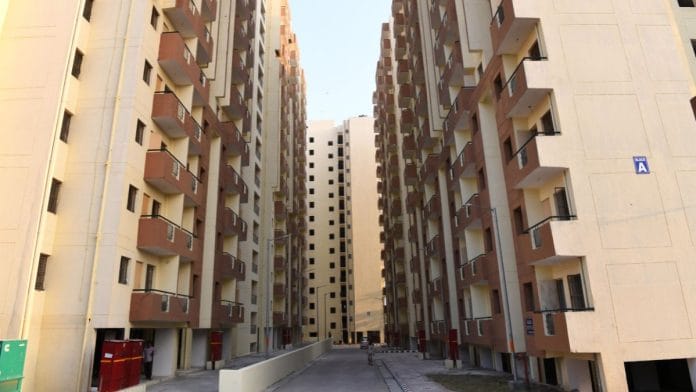New Delhi: Nearly 46 percent of the 9.69 lakh houses constructed for the urban poor under Pradhan Mantri Awas Yojana-Urban (PMAY-U) are unoccupied due to incomplete infrastructure and delays in allotment, the Union Ministry of Housing and Urban Affairs (MoHUA) informed a House panel in the first batch of Supplementary Demand for Grants for 2024-2025.
In its first report on the Demand for Grants (2024-25) for the ministry tabled in Parliament Tuesday, the Standing Committee on Housing and Urban Affairs recommended that the ministry “closely monitor the progress of housing projects” and clear the bottlenecks in the construction and allotment process.
The Modi government launched PMAY-U in 2015 with the mission to provide housing for all. Under the flagship scheme, the MoHUA has sanctioned 17.5 lakh houses since 2015—15.65 under the Affordable Housing in Partnership (AHP) and 1.84 lakh under In-situ Slum Rehabilitation (ISSR) verticals—for the economically weaker section and those living in slums.
While 9.69 lakh houses were “completed” between 2015 and 2024, nearly 4.59 lakh of these properties are lying vacant.
The ministry informed the committee that the main reasons for the large-scale vacancy of completed houses are “incomplete infrastructure, non-allotment of houses, and unwillingness of allottees”.
The committee, chaired by Telugu Desam Party (TDP) MP Magunta Sreenivasulu Reddy, said, “The Committee are of the opinion that unoccupancy of completed houses for whatsoever reason will defeat the very purpose of the Mission.”
After the Standing Committees were set up in September, the first report on the Demand for Grants report was tabled in the Parliament on 10 December.
‘Allocations under PMAY-U 2.0 have started’
In total, 118 lakh houses have been sanctioned under PMAY across the country since 2015. This includes the 17.5 lakh house sanctioned by the MoHUA.
According to the information provided by the ministry, the panel observed that the overall completion rate under PMAY-U (phase 1) across states and UTs stood at 71 percent. It recommended that the ministry take immediate and decisive action to “prioritise timely completion”. The first phase of PMAY-U ends on 31 December, 2024.
With the launch of PMAY-U 2.0, the Standing Committee recommended the ministry issue the necessary directions to states and Union territories to “incorporate the trunk infrastructure development as part of their proposals for houses under the verticals aimed at providing housing to urban poor under the second phase of the mission”.
PMAY-U 2.0 was launched in September this year to provide one crore houses in urban areas.
The ministry has started the allocation of new houses to states and UTs under phase 2 of the mission, said Union Housing and Urban Affairs Minister Manohar Lal Khattar during a media interaction Tuesday.
“Over 6 lakh houses have been sanctioned to 29 states and UTs so far. The total number of houses to be sanctioned to states will be announced by March next year based on the state-level survey,” said Khattar.
Increase the financial assistance, panel tells Centre
With Phase 2 allocations underway, the House panel has recommended the ministry consider increasing the financial assistance to beneficiaries due to high construction and land costs.
Under PMAY-U 2.0, central assistance will provide a fixed Rs 1.5 lakh per unit for Affordable Housing in Partnership (AHP) and Beneficiary Led Construction (BLC) verticals of PMAY to states. For UTs and hill states, the amount varies between Rs 2.25 lakh to Rs 2.5 lakh.
“The Committee feels that housing construction costs have significantly escalated in recent years and the existing financial assistance under PMAY(U) may no longer be sufficient for beneficiaries to fully realise the goal of owning a house,” the report said.
The House panel said that it is essential that the financial support provided to beneficiaries reflect the current market dynamics and the increased cost of construction materials, labour, and other factors that impact overall building expenses.
“The Committee, therefore, urge the Ministry to conduct a detailed review of the cost structure of housing projects under PMAY 2.0, in consultation with stakeholders including State Governments, Urban Local Bodies (ULBs) and construction experts to arrive at a more realistic and adequate financial assistance framework and may consider increasing the financial assistance to be provided to beneficiaries under PMAY-U 2.0,” it said.
(Edited by Sanya Mathur)
Also Read: Centre to use GIS-based tech to identify projects under MGNREGS & streamline them






